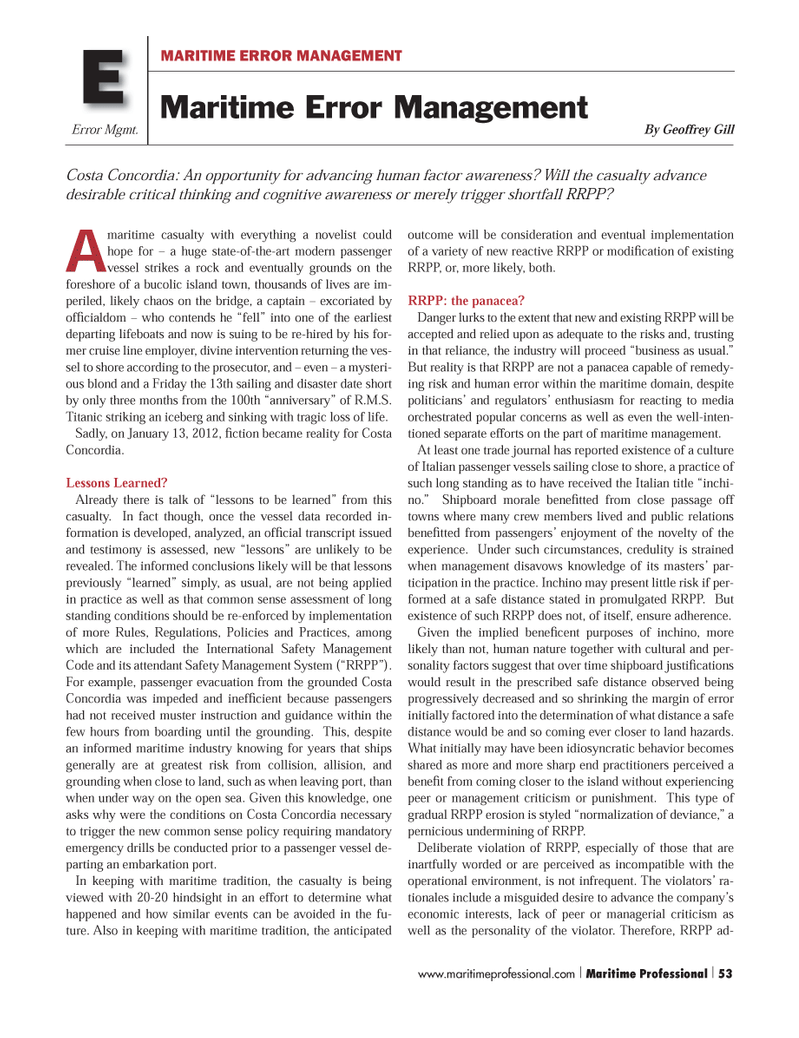
Page 53: of Maritime Logistics Professional Magazine (Q1 2013)
Maritime Risk
Read this page in Pdf, Flash or Html5 edition of Q1 2013 Maritime Logistics Professional Magazine
Error Mgmt. MARITIME ERROR MANAGEMENT Maritime Error Management EBy Geoffrey Gill Costa Concordia: An opportunity for advancing human factor awareness? Will the casualty advance desirable critical thinking and cognitive awareness or merely trigger shortfall RRPP? A maritime casualty with everything a novelist could hope for ? a huge state-of-the-art modern passenger vessel strikes a rock and eventually grounds on the foreshore of a bucolic island town, thousands of lives are im- periled, likely chaos on the bridge, a captain ? excoriated by of cialdom ? who contends he ?fell? into one of the earliest departing lifeboats and now is suing to be re-hired by his for- mer cruise line employer, divine intervention returning the ves- sel to shore according to the prosecutor, and ? even ? a mysteri- ous blond and a Friday the 13th sailing and disaster date short by only three months from the 100th ?anniversary? of R.M.S. Titanic striking an iceberg and sinking with tragic loss of life. Sadly, on January 13, 2012, ction became reality for Costa Concordia. Lessons Learned? Already there is talk of ?lessons to be learned? from this casualty. In fact though, once the vessel data recorded in- formation is developed, analyzed, an of cial transcript issued and testimony is assessed, new ?lessons? are unlikely to be revealed. The informed conclusions likely will be that lessons previously ?learned? simply, as usual, are not being applied in practice as well as that common sense assessment of long standing conditions should be re-enforced by implementation of more Rules, Regulations, Policies and Practices, among which are included the International Safety Management Code and its attendant Safety Management System (?RRPP?). For example, passenger evacuation from the grounded Costa Concordia was impeded and inef cient because passengers had not received muster instruction and guidance within the few hours from boarding until the grounding. This, despite an informed maritime industry knowing for years that ships generally are at greatest risk from collision, allision, and grounding when close to land, such as when leaving port, than when under way on the open sea. Given this knowledge, one asks why were the conditions on Costa Concordia necessary to trigger the new common sense policy requiring mandatory emergency drills be conducted prior to a passenger vessel de- parting an embarkation port.In keeping with maritime tradition, the casualty is being viewed with 20-20 hindsight in an effort to determine what happened and how similar events can be avoided in the fu- ture. Also in keeping with maritime tradition, the anticipated outcome will be consideration and eventual implementation of a variety of new reactive RRPP or modi cation of existing RRPP, or, more likely, both. RRPP: the panacea?Danger lurks to the extent that new and existing RRPP will be accepted and relied upon as adequate to the risks and, trusting in that reliance, the industry will proceed ?business as usual.? But reality is that RRPP are not a panacea capable of remedy-ing risk and human error within the maritime domain, despite politicians? and regulators? enthusiasm for reacting to media orchestrated popular concerns as well as even the well-inten- tioned separate efforts on the part of maritime management. At least one trade journal has reported existence of a culture of Italian passenger vessels sailing close to shore, a practice of such long standing as to have received the Italian title ?inchi- no.? Shipboard morale bene tted from close passage off towns where many crew members lived and public relations bene tted from passengers? enjoyment of the novelty of the experience. Under such circumstances, credulity is strained when management disavows knowledge of its masters? par- ticipation in the practice. Inchino may present little risk if per- formed at a safe distance stated in promulgated RRPP. But existence of such RRPP does not, of itself, ensure adherence. Given the implied bene cent purposes of inchino, more likely than not, human nature together with cultural and per- sonality factors suggest that over time shipboard justi cations would result in the prescribed safe distance observed being progressively decreased and so shrinking the margin of error initially factored into the determination of what distance a safe distance would be and so coming ever closer to land hazards. What initially may have been idiosyncratic behavior becomes shared as more and more sharp end practitioners perceived a bene t from coming closer to the island without experiencing peer or management criticism or punishment. This type of gradual RRPP erosion is styled ?normalization of deviance,? a pernicious undermining of RRPP. Deliberate violation of RRPP, especially of those that are inartfully worded or are perceived as incompatible with the operational environment, is not infrequent. The violators? ra- tionales include a misguided desire to advance the company?s economic interests, lack of peer or managerial criticism as well as the personality of the violator. Therefore, RRPP ad- www.maritimeprofessional.com | Maritime Professional | 53MP #4 50-63.indd 53MP #4 50-63.indd 532/25/2013 9:58:30 AM2/25/2013 9:58:30 AM

 52
52

 54
54
